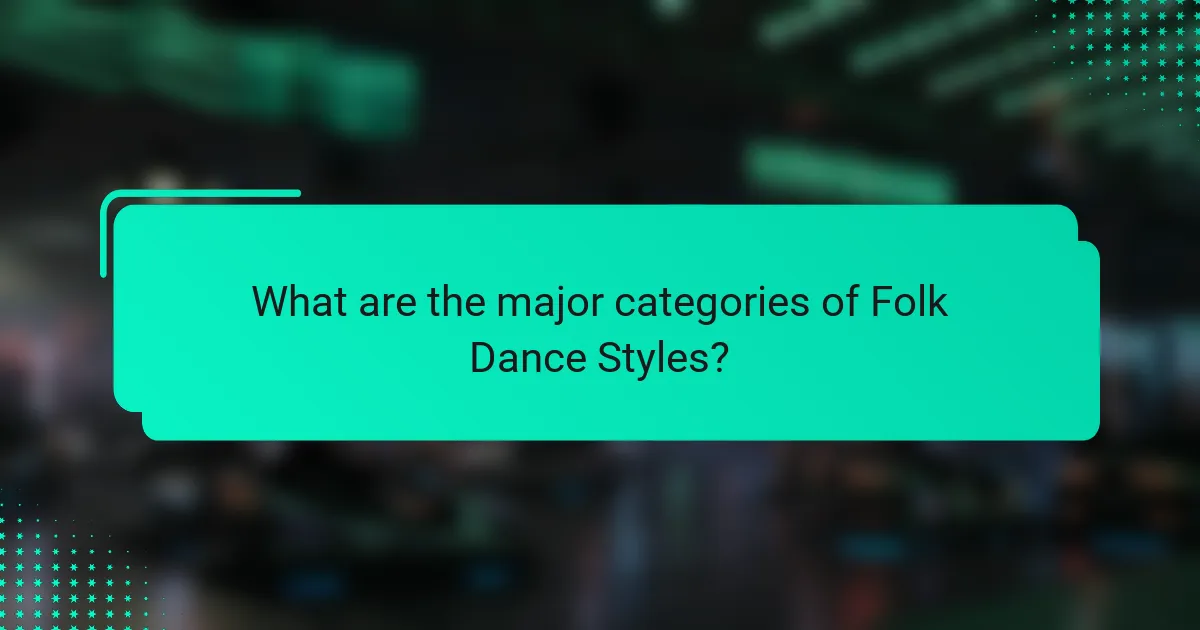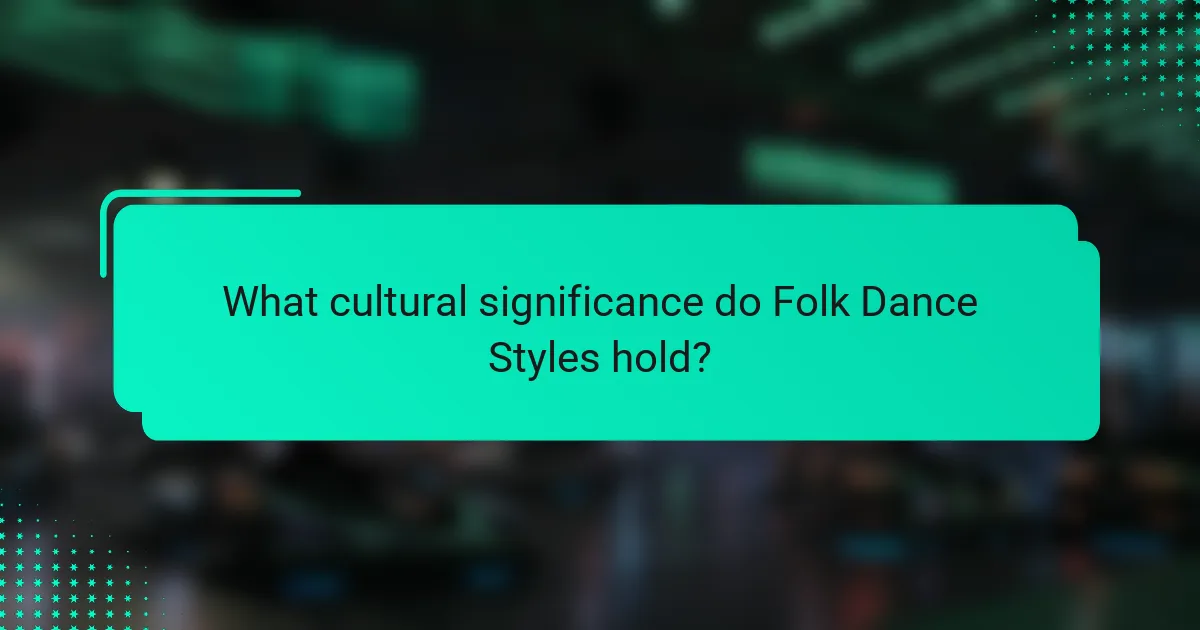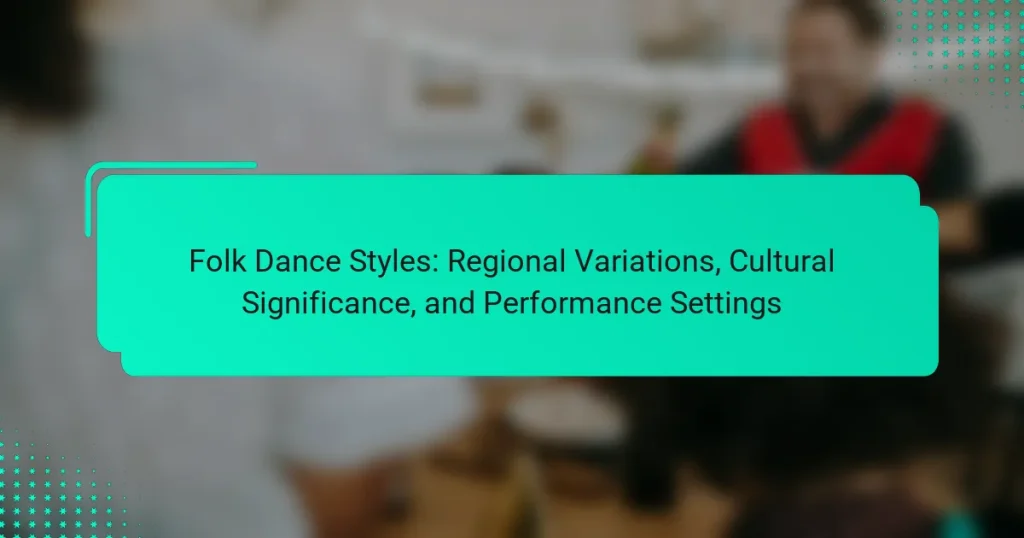Folk dance styles are traditional dances that embody the cultural heritage of specific communities, showcasing a diverse array of regional variations influenced by local music and costumes. These dances serve as a medium for storytelling, celebrating historical events, and marking seasonal changes, with notable examples including the Irish jig, Spanish flamenco, and American square dance. The article explores major categories of folk dance, such as traditional, regional, and contemporary, highlighting their cultural significance and role in preserving community identity. Additionally, it examines how folk dances promote social cohesion and community participation during festivals and celebrations, reinforcing cultural continuity and pride among generations.

What are Folk Dance Styles?
Folk dance styles are traditional dances that reflect the cultural heritage of specific communities. These styles vary significantly across regions and often incorporate local music and costumes. Each folk dance serves as a means of storytelling, celebrating historical events, or marking seasonal changes. Common examples include the Irish jig, the Spanish flamenco, and the American square dance. Folk dances are typically performed at social gatherings, festivals, and cultural celebrations. They often involve community participation, fostering a sense of belonging and identity. Research shows that folk dances play a vital role in preserving cultural traditions and promoting social cohesion.
How do Folk Dance Styles vary across different regions?
Folk dance styles vary significantly across different regions due to cultural, historical, and social influences. Each region develops unique dance forms that reflect its traditions and values. For example, Irish step dancing features intricate footwork and is characterized by a stiff upper body. In contrast, Flamenco from Spain emphasizes expressive arm movements and dramatic flair.
In Eastern Europe, dances like the Polka and Mazurka are popular, showcasing lively rhythms and community participation. African folk dances often involve vibrant music and storytelling elements, emphasizing communal bonds. Additionally, Native American dances vary widely among tribes, each with distinct purposes and ceremonial significance.
These regional styles are shaped by local customs, historical events, and interactions with neighboring cultures. Such diversity highlights the rich tapestry of human expression through dance.
What are the key characteristics of folk dances in Europe?
Folk dances in Europe are characterized by their regional diversity, cultural significance, and specific performance settings. Each dance reflects the traditions and history of its region. Common features include unique musical styles and traditional costumes. Many dances involve group participation, emphasizing community and social interaction. The movements often mimic daily activities or historical events. Folk dances are typically performed at festivals, weddings, and community gatherings. They serve to preserve cultural heritage and foster a sense of identity. Various European countries have distinct folk dance styles, such as the Irish jig, Spanish flamenco, and Bulgarian horo. These dances often have specific rhythms and formations that vary by region.
How do Asian folk dance styles differ from those in Africa?
Asian folk dance styles often emphasize intricate movements and storytelling. Many Asian dances incorporate elements of theater and symbolism. For example, Indian classical dance forms like Bharatanatyam focus on [censured] expressions and hand gestures. In contrast, African folk dance styles prioritize community participation and rhythm. African dances often involve large groups and are performed during celebrations or rituals. The use of percussion instruments is more pronounced in African dances. Additionally, the movements in African dance are often grounded and expressive, showcasing physical strength. These differences highlight the unique cultural contexts and values present in each region’s folk dance traditions.
Why are Folk Dance Styles significant to cultural identity?
Folk dance styles are significant to cultural identity because they embody the traditions, values, and historical narratives of a community. These dances serve as a means of expressing shared heritage and collective memory. They often reflect the social customs and beliefs of a specific region or group. For instance, traditional dances may incorporate unique music, costumes, and movements that are characteristic of a culture. Additionally, folk dances foster community cohesion by bringing people together during celebrations and rituals. Research shows that participating in folk dance can enhance cultural pride and continuity among younger generations. Thus, folk dance styles are vital for preserving cultural identity and promoting social unity.
How do folk dances reflect the history of a community?
Folk dances reflect the history of a community by embodying its cultural narratives and traditions. These dances often tell stories of historical events, social struggles, and daily life. For instance, specific movements and styles may originate from significant historical periods or events. In many cases, folk dances incorporate traditional music and costumes that highlight the community’s heritage. This connection to history fosters a sense of identity and continuity among community members. Furthermore, folk dances are often passed down through generations, preserving the community’s collective memory. Research shows that communities use these dances to celebrate milestones and cultural festivals, reinforcing their historical significance. Thus, folk dances serve as a living archive of a community’s past and cultural evolution.
What role do folk dances play in preserving traditions?
Folk dances play a crucial role in preserving traditions. They serve as a medium for transmitting cultural heritage across generations. These dances often embody historical narratives, social values, and community identity. Participation in folk dances fosters a sense of belonging among community members. They are typically performed during festivals, rituals, and celebrations, reinforcing cultural practices. Research indicates that folk dances contribute to cultural continuity by maintaining unique customs and practices. For example, the preservation of traditional attire and music in folk dance performances reflects regional identities. Thus, folk dances are vital in sustaining and celebrating cultural traditions.

What are the major categories of Folk Dance Styles?
The major categories of folk dance styles include traditional, regional, and contemporary. Traditional folk dances represent the cultural heritage of specific communities. These dances often reflect historical events, customs, and rituals. Regional folk dances vary significantly based on geographical locations. Each region has its unique styles, influenced by local traditions and practices. Contemporary folk dances may blend traditional elements with modern influences. They often evolve to reflect current social themes and artistic trends. These categories help in understanding the diversity and significance of folk dance across cultures.
What are the different types of folk dances?
Folk dances can be categorized into several types based on regional variations and cultural significance. Common types include traditional dances, which reflect the heritage of specific communities. Examples are Irish jigs, Spanish flamenco, and Indian bhangra. Social dances are performed at community gatherings, such as square dancing in the United States. Ritual dances are linked to religious or ceremonial events, like Native American powwow dances. Additionally, there are occupational dances that depict work-related activities, such as the harvest dances in agricultural societies. Each type of folk dance serves to preserve cultural identity and foster community bonds through shared traditions.
How do social dances differ from ceremonial dances?
Social dances and ceremonial dances differ primarily in their purpose and context. Social dances are typically performed for enjoyment and entertainment in informal settings. They often involve spontaneous participation and focus on social interaction among dancers. In contrast, ceremonial dances are performed for specific rituals or cultural events. They often carry significant meaning and are structured to honor traditions or commemorate occasions.
Social dances, such as square dancing or salsa, emphasize personal expression and community bonding. Ceremonial dances, like Native American powwow dances or wedding dances, are usually performed with specific cultural symbolism and often require traditional attire. This distinction highlights the varying functions of dance within cultural practices.
What are some examples of narrative folk dances?
Examples of narrative folk dances include the Russian Troika, the Spanish Flamenco, and the Indian Kathak. The Troika tells stories of travel and adventure through its lively movements. Flamenco expresses deep emotions, often depicting themes of love and struggle. Kathak narrates tales from Indian epics using intricate footwork and [censured] expressions. These dances are rooted in cultural traditions and often performed during festivals and celebrations. Each dance form serves as a medium for storytelling, reflecting the history and values of its community.
How do performance settings influence Folk Dance Styles?
Performance settings significantly influence folk dance styles by shaping their presentation and cultural expression. Different venues, such as festivals, community gatherings, or theaters, affect how dances are performed. For instance, outdoor festivals often encourage more energetic and participatory styles. In contrast, formal theater settings may emphasize precision and choreography.
The audience’s expectations also play a crucial role. In intimate settings, dancers may engage more directly with viewers, fostering a sense of connection. Cultural significance is highlighted in performance settings that honor tradition, such as during rituals or ceremonies.
Historical context shows that changes in performance settings have led to adaptations in dance styles. For example, the transition from rural to urban settings has introduced new influences and choreography. This evolution illustrates how folk dance remains dynamic and responsive to its environment.
What are the typical venues for folk dance performances?
Typical venues for folk dance performances include community centers, outdoor festivals, and cultural events. These settings provide an accessible platform for local communities to showcase their traditions. Schools and universities also serve as venues, often hosting performances for educational purposes. Theaters and auditoriums can accommodate larger audiences and formal presentations. Additionally, public parks and open-air spaces are popular for seasonal celebrations. Each venue type enhances the cultural significance of folk dance by fostering community engagement and participation.
How does the audience’s role change in different settings?
The audience’s role changes significantly in different settings. In formal settings, audiences often engage passively, observing performances without interaction. This contrasts with informal settings, where audiences may participate actively, joining in the dance. Cultural traditions influence audience behavior; for example, in some cultures, audience participation is encouraged during folk dances. Additionally, the setting can dictate the level of audience engagement; festivals often promote higher interaction than theater performances. Research shows that audience involvement enhances the overall experience and cultural appreciation. A study by Cohen et al. (2019) highlights that active participation in folk dance settings fosters community bonds and cultural identity.

What cultural significance do Folk Dance Styles hold?
Folk dance styles hold significant cultural importance as they reflect the traditions and values of specific communities. These dances serve as a means of preserving cultural heritage and identity. They often embody historical narratives, rituals, and social norms unique to a region. For instance, the Irish jig showcases the lively spirit of Irish culture, while the Flamenco represents the deep emotional expression found in Spanish tradition. Folk dances facilitate community bonding and social cohesion through collective participation. They are frequently performed during festivals, celebrations, and rituals, reinforcing cultural continuity. Studies show that folk dance participation enhances cultural pride and awareness among younger generations.
How do folk dances convey cultural stories and values?
Folk dances convey cultural stories and values through movement, music, and attire. These elements reflect historical events, traditions, and social norms. Each dance often tells a story, illustrating community life and shared experiences. For example, the Irish jig showcases joy and celebration, while the Indian Bharatanatyam expresses religious themes. The choreography typically incorporates symbolic gestures that represent cultural beliefs. Additionally, folk dances are often performed during festivals, reinforcing community bonds and cultural identity. Historical records show that many folk dances have been passed down through generations, preserving cultural heritage. This transmission of dance ensures that stories and values remain alive within the community.
What themes are often represented in folk dance choreography?
Folk dance choreography often represents themes such as community, tradition, and cultural identity. These themes reflect the social and historical contexts of the dances. Community themes highlight collective participation and shared experiences. Tradition themes emphasize the preservation of cultural practices and rituals. Cultural identity themes express the uniqueness of a specific group or region. Many folk dances narrate stories or events significant to the community. For example, dances may celebrate harvests or historical milestones. This thematic representation fosters a sense of belonging and continuity within cultural groups.
How do costumes and music enhance the cultural narrative?
Costumes and music enhance the cultural narrative by visually and audibly representing a community’s identity. Costumes reflect historical traditions, regional characteristics, and social values. They often incorporate specific colors, patterns, and styles that signify cultural heritage. Music complements this by conveying emotions and stories inherent to the culture. It incorporates traditional instruments and rhythms that resonate with the community’s history. Together, they create an immersive experience that communicates cultural significance. For example, the vibrant costumes and folk music of the Irish dance showcase the rich storytelling tradition of Ireland. This synergy between costumes and music fosters a deeper understanding of cultural narratives.
What impact do Folk Dance Styles have on community engagement?
Folk dance styles significantly enhance community engagement by fostering social interaction and cultural exchange. These dance styles often involve group participation, which builds a sense of belonging among community members. They serve as a platform for sharing traditions and stories, strengthening cultural identity. Studies indicate that communities with active folk dance practices report higher levels of social cohesion and collective identity. Additionally, folk dance events often attract diverse participants, promoting inclusivity and understanding among different cultural backgrounds. This engagement can lead to increased participation in other community activities and initiatives. Overall, folk dance styles play a crucial role in uniting individuals and enriching community life.
How can participating in folk dance foster community bonds?
Participating in folk dance fosters community bonds by bringing individuals together through shared cultural expression. Folk dance encourages collaboration and teamwork as participants learn and perform together. This collective activity builds trust and mutual understanding among community members. Additionally, folk dance often reflects local traditions and history, reinforcing a sense of identity. Events centered around folk dancing create social opportunities for interaction, enhancing relationships. Studies show that community engagement in such activities can lead to increased social cohesion. For example, a 2018 study by the National Endowment for the Arts found that community dance programs significantly improved neighborhood ties. Thus, folk dance serves as a vital tool for strengthening community connections.
What are some best practices for organizing community folk dance events?
Engaging community members is essential for organizing successful folk dance events. Start by forming a planning committee with diverse representation. This ensures a range of ideas and perspectives. Next, choose an appropriate venue that accommodates the expected number of participants and offers a suitable dance floor.
Promote the event through local channels, including social media, community boards, and flyers. This increases visibility and encourages attendance. Schedule practice sessions before the event to familiarize participants with the dances. Providing accessible instructional materials can enhance participant confidence.
Consider incorporating local cultural elements to enrich the experience. This fosters community pride and connection. Lastly, gather feedback post-event to improve future gatherings. Collecting insights helps refine organization strategies and enhances overall community engagement.
Folk dance styles are traditional dances that embody the cultural heritage of distinct communities, showcasing regional variations influenced by local customs and historical narratives. This article explores the diversity of folk dance across different regions, highlighting key characteristics, types, and the role of performance settings in shaping these dances. It emphasizes the cultural significance of folk dances in preserving traditions, fostering community engagement, and conveying cultural stories through movement, music, and attire. Additionally, the article discusses best practices for organizing community folk dance events to enhance participation and strengthen social bonds.




